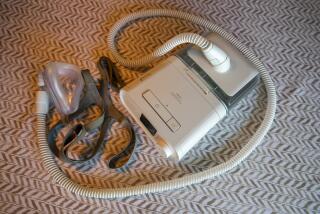Data Raises New Concerns on Breast Implant Safety
- Share via
WASHINGTON — Internal company memos released Monday by Dow Corning Wright, the leading manufacturer of silicone gel breast implants, raise new concerns about whether exercises routinely recommended to keep the implants supple may contribute to their rupture.
The new memos are among hundreds of pages of documents related to the safety of the controversial devices made public by the company.
In an accompanying statement, the firm said it has known for 20 years that some silicone gel would seep out of the implants’ envelopes but that officials did not believe that the leakage would cause health problems.
Patients who receive breast implants are instructed by their plastic surgeons to massage the breasts on a regular basis to prevent capsular contracture, a hardening of the breast that results after scar tissue has formed around the implant. But that massage, some of the memos suggested, could cause some implants to break, leaking silicone gel into surrounding tissues.
The leakage of silicone gel has been linked to cancer and autoimmune diseases, although the connection has not been proved.
So serious has the overall issue of the implants’ safety become that Dow Corning Corp., the corporate parent of Dow Corning Wright, announced a shift in its top officers Monday. Keith R. McKennon was named chief executive officer and chairman of the board. He replaces Lawrence A. Reed as CEO and John S. Ludington as board chairman. Reed will continue as president.
McKennon will concentrate on breast implant-related issues, while Reed will run the corporation’s global operations, the company said.
“It is clear to the board (that) the company must focus full-time top executive attention to both the complex issues related to silicone breast implants as well as the ongoing operations of the company,” Ludington, who will remain on the board of directors, said in a statement.
Spokeswoman Barbara Carmichael said Monday night that the company has been “trying to focus on addressing some of the needs of women who have had these implants. One of the ideas we are kicking around” is to offer financial help to women who want to remove their implants but cannot afford to do so.
McKennon, an executive vice president of Dow Chemical Co., has served as a trouble-shooter for the chemical manufacturer. In the early 1980s, he handled health and regulatory issues related to Dow’s manufacture of Agent Orange, the controversial defoliant used in the Vietnam War that has been blamed for illnesses of veterans who were exposed to it.
He also handled the controversy over Bendectin, an anti-nausea drug made by Merrell Dow Pharmaceuticals Inc. The drug, widely prescribed to pregnant women, was taken off the market in 1983 after numerous lawsuits linked it to birth defects.
McKennon is still a Dow Chemical director but has retired from active management. He joined Dow in 1955, was named to the board of directors in 1983 and became president of Dow USA and executive vice president in 1987.
The new material about ruptures is connected to a Michigan legal case against Dow Corning Wright that has not yet gone to trial. It was brought to the attention of Food and Drug Commissioner David A. Kessler late last week by Rep. Ted Weiss (D-N. Y.), chairman of a House subcommittee that has been investigating the safety of breast implants for more than a year.
Because the documents are under a protective court order, Kessler asked the company to include the papers with documents already scheduled to be released.
The Food and Drug Administration, which was legally prohibited from releasing company documents in its possession, last month asked the firm to make the papers public in the wake of growing concerns about the safety of the implants.
The package of documents released Monday also includes other internal Dow Corning Wright memos, scientific studies and letters of complaint, already widely reported, that span two decades beginning in the early 1970s.
The memos depict the manufacturer as eager to market a new line of implants and reluctant to conduct studies on the health consequences of silicone gel leakage.
Robert Rylee, chairman of health care businesses for Dow Corning Wright, stressed at a press conference Monday that the company continues to believe “science supports the safety and effectiveness of breast implants.”
As for the memos, he said: “We have nothing to hide, and we believe that each, placed in the proper context, can be explained. . . . They are not scientific, and they reflect the kind of dialogue that often takes place within a company.”
The documents, which already had been obtained by the FDA, prompted Kessler on Jan. 6 to call for a voluntary moratorium on the sale and use of the implants while an FDA advisory panel studies the new information and deliberates further on whether they should remain on the market.
The committee is slated to meet for three days next week, beginning Feb. 18.
The material that most recently came to Kessler’s attention focuses on the rate of rupture and whether the exercises could play a role.
In a Feb. 29, 1984, memo, for example, Eldon Frisch, a Dow Corning Wright official, described numerous communications with Dr. Charles A. Vinnik, a Las Vegas plastic surgeon. Frisch said Vinnik complained that the envelopes around the implant “were defective, with thin spots causing them to be easily ruptured.”
The Las Vegas doctor provided him with a copy of instructions of breast exercises that he had given to his patients, Frisch wrote.
“After reviewing this, it is obvious why envelopes and gel are destroyed,” Frisch wrote. “If his patients usually manipulate the implant to the extent shown in these instructions, it would be reasonable to think that the envelope is repeatedly stretched to a degree approaching its ultimate elongation.”
Such manipulation would result in “stressing some areas of the implant,” Frisch wrote, adding that “this type of manipulation would also probably break up the gel and change its . . . properties.”
An Oct. 15, 1985, letter from Dr. David Mobley, a Jacksonville, Fla., plastic surgeon, to Dan Hayes, president of Dow Corning Wright, ended the surgeon’s agreement to purchase further implants from the company.
“I have reached this decision after having recurring problems over the past two years with spontaneous unexplainable rupture of mammary implants,” he wrote. “Also, there seems to be a marked inconsistency of shell thickness and gel consistency when one manually examines the implants.”
A Dec. 15, 1977, memo from Frank Lewis, a company official, said the rupture problem was “still recurring at an inordinate rate” and described the experiences of several physicians “who have experienced an abnormal percentage of ruptures.”
Lewis wrote: “I am sure some of these were the fault of the doctor, but that alone could not account for such a high percentage of ruptures. These doctors have, on the average, 10 years’ experience.”
Rylee insisted that information provided to patients from the company has always mentioned the possibility that massage may cause rupture, but he stopped short of warning against the practice.
“We’re not saying: ‘Don’t do it,’ if it is helpful,” Rylee said. Nevertheless, “we have been concerned about the amount of massage and we have cautioned about it,” he added.
He said the majority of surgeons’ complaints about ruptures concerned those that have occurred preoperatively, “when the surgeon is trying to insert it,” and that the total number of rupture reports has never been greater than 0.5%.
Dr. Norman Cole, president of the American Society of Plastic and Reconstructive Surgeons, said he had read plastic surgeon Vinnik’s exercise instructions and believed them to be too strenuous and not the massage that is typically recommended.
“His regimen was extreme,” Cole said.
Cole said surgeons typically instruct implant patients to move the implant through the space created by the surgery--which is much larger than the size of the implant--and to “push the implant from one part of the cavity to another.” He said that routine should not be strenuous enough to break the device.
Cole said he would not recommend that women stop performing the massage. “I think it does help,” he said.
In addition to a possible link with cancer, the implants also have been blamed by some women for autoimmune disorders, including arthritis and lupus.
More to Read
Inside the business of entertainment
The Wide Shot brings you news, analysis and insights on everything from streaming wars to production — and what it all means for the future.
You may occasionally receive promotional content from the Los Angeles Times.










